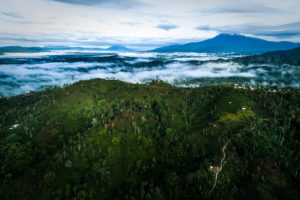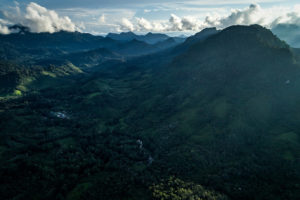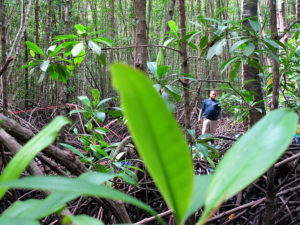
If hearing the word “soy” makes you think of tofu, edamame and soy sauce, think again.
Soybean is a “hidden commodity”, and most consumers have no idea how much of the legume they eat daily. Not only is it found in thousands of processed foods and products, from margarine and chocolate to cosmetics and soaps, rising demand for meat has driven soy production to nearly 10 times what it was 50 years ago.
A full 80 percent of the world’s soybean crop is fed to livestock. Much of it is produced in the Amazon and Cerrado ecosystems of Brazil, which each lose between 5 to 10,000 square kilometers of forest each year, despite public and private efforts to limit soy production to land that has already been cleared.
Today, 2 to 4 percent of global soy production is certified as responsible, representing a niche market of concerned consumers who are willing to pay more for products guaranteed to be emissions and deforestation-free. But do such guarantees actually reduce deforestation?
Not necessarily, according to recent research by the University of Bonn’s Center for Development Research and the Center for International Forestry Research (CIFOR), which compared seven soy certification schemes in Brazil.
“We find that these schemes may be able to provide consumers with deforestation-free products, but they cannot generally safeguard against the negative impacts of increasing land footprints,” said Jan Börner, a CIFOR senior associate and professor of Economics of Sustainable Land Use and Bio-economy at the University of Bonn, who co-authored a policy brief that sums up the research results.
Although all seven schemes commit to preventing illegal deforestation and support the enforcement of national laws for natural ecosystem preservation on private properties, they may simply relocate sourcing patterns or provoke indirect land use change – which is known to occur but difficult to measure.
“As long as it is a niche market, you can source soy from already deforested landscapes and label it deforestation-free,” Börner said. “So consumers are eventually paying for something that is very easy to provide, but doesn’t actually reduce deforestation.”
Additionally, some studies argue that confining soybean production to already cleared land – which is widely available – is pushing cattle production to expand new pastures along the forest margins. By converting low-value pastures to high-value cropland, cattle farmers are benefiting from differences in land prices by selling high and buying low, reinvesting profits and effectively ramping up overall cattle production.
This causes a cascading effect of different agricultural land uses with time lags, making it difficult to point the finger at specific drivers of deforestation. If the construction of roads and highways needed to get soy to export markets is factored in, it’s estimated that as much as one-third of Amazon deforestation since 2002 can be attributed indirectly to soybean expansion.
Read also: Decoding deforestation in Brazil and Bolivia

INCENTIVE OR DISINCENTIVE
Another factor that limits the spread of voluntary certification especially for bulk commodities is low cost-effectiveness. Certification costs are similar for most schemes, but the cost of implementing them can be prohibitive, depending on the supply chain model. A combination of high transaction costs and low price premiums lower the appeal for producers – especially smallholders – to invest in certification.
“For farmers who don’t have to change anything, it’s a no-regret effort to get certified,” Börner said. “But for those who would have to significantly adjust the way they operate, the premiums are too low to create the incentive to change.”
Therefore, the effect of certification is to simply shift sourcing to farmers who can provide deforestation-free soy at relatively little or no opportunity cost, rather than encouraging those who are actually driving deforestation to change their behavior.
“We’re talking about harnessing consumers’ willingness to pay for conservation, but we’re not doing that,” Börner adds. “We’re just channeling rents to different producers that happen to be deforestation-free, but this money is not actually reducing any deforestation.”
This is not to say that certification doesn’t work.
“It does work in some contexts,” Börner said. “In Indonesia, for example, FSC [Forest Stewardship Council] certification was shown to make a significant contribution to natural forest conservation. Tropical timber is different than agricultural crops, though. It is primarily sourced from forest landscapes, where the adoption of sustainable practices can make a difference.”
As such, the voluntary standards and certification may serve as a complementary strategy, but they all hinge on appropriate and well implemented national.
“If you’re not even able to measure whether people are complying with national legislation, how can you ensure standards are delivering what they promise?” Börner said. “These value chain governance measures cannot serve as stand-alone tools to avoid illegal or undesired forms of deforestation – they have to be implemented in line with existing policies that need to be strengthened.”
Read also: Deep down in supply chains, zero deforestation commitments look different to what appears on paper
IF NOT CERTIFICATION, THEN WHAT?
The authors examine how responsible consumption initiatives could limit unsustainable expansion of soy production. Since voluntary payments such as certification are likely to remain niche markets, the scale of impact will be minimal unless these investments can be channeled into initiatives that can actually show impact.
For instance, if the willingness of consumers to pay for reducing their land footprint could be harnessed to finance direct conservation measures in areas threatened by deforestation, there is potential to make a big difference.
Based on this insight, Börner suggests that offsetting may be a more effective mechanism than certification.
For example, rather than paying a higher price for a certified soy product and having that money passed on to producers who just happen to cultivate soy without causing deforestation, consumers of products that are known to be associated with deforestation could be offered to support initiatives that demonstrate actual conservation impact on the ground.
“So you’re not guaranteeing the product is emission-free, but you’re guaranteeing that the extra money is actually going towards land-based emissions reduction,” he said. “Otherwise you’re actually blinding the consumer with a certificate that claims deforestation has been avoided, when it’s not actually the case.”
By Erin O’Connell, originally published at CIFOR’s Forests News.
For more information on this topic, please contact Jan Börner at jborner@uni-bonn.de.
This research forms part of the CGIAR Research Program on Forests, Trees and Agroforestry, which is supported by the CGIAR Trust Fund.
















